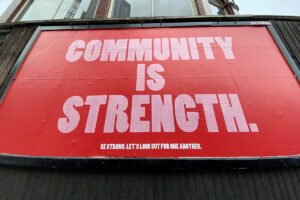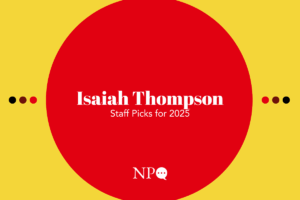
What does it mean to be an anchor? How does it benefit residents in our community? Being an “anchor” refers to a framework for making business decisions around hiring, purchasing, and investing that consider the impact on the health of an institution’s local community.
—Boston Children’s Hospital Anchor Strategy
What is the responsibility of nonprofits to the broader public—and do large nonprofit institutions such as hospitals and universities have an outsized level of responsibility?
Often, if you say the word “nonprofit,” what comes to mind are small community-based organizations. Or perhaps people might name large national human service networks, such as Feeding America. But this perception leaves out many, and the most common, nonprofits.
Hospitals occupy a dominant position within the nonprofit sector—as NPQ illustrated based on National Center for Charitable Statistics data—with $964 billion in annual revenue, nearly as much as all other nonprofits combined. If you add “health”—listed as a separate category, which, alas, is perhaps a telling distinction—that number climbs another $211 billion.
Combined, hospitals and health nonprofits comprise a clear majority of total US nonprofit annual revenue. And the larger hospitals, especially, play such an important economic role in their communities that many of them are often referred to not just as nonprofits, but as anchor institutions.
Emergence of the Anchor Idea
What is an anchor institution? The idea is simple enough. An anchor institution is simply a nonprofit or publicly owned institution that, by nature of its ownership and sunk physical capital (such as extensive campuses of buildings), cannot easily move—as opposed to sports teams and for-profit corporations that move regularly.
There is nothing virtuous per se about being an anchor institution. However, being “anchored” in place means that the institution has at least some interest in the wellbeing of the community that surrounds it since it cannot easily move elsewhere.
In some—but not all—cases, this leads nonprofits to adopt what my colleague Rita Hodges and I years ago called an anchor mission, which is an explicit institutional commitment to “strategically apply the institution’s long-term, place-based economic power, in combination with its human and intellectual resources, to better the welfare of the community in which it resides.”
There are multiple reasons for anchor strategies.…The main concept is to align nonprofit business functions with mission.
In 2005, a foundation experiment in this direction, called the Greater University Circle Initiative, was launched by the Cleveland Foundation—the nation’s oldest and third-largest community foundation. According to the foundation, the “Greater” University Circle included the neighborhoods of Hough, Fairfax, Central, East Cleveland, Glenville, Little Italy, and Buckeye-Shaker. These neighborhoods had, as of 2012, a very low median household income of $18,500 and 24 percent unemployment.
The vision, then-program officers India Pierce Lee and Lillian Kuri explained, was to advance a “multiple-anchor strategy” and forge “a collaborative, innovative, and equitable approach to neighborhood redevelopment” focused on supporting low-income, majority Black neighborhoods in neighborhoods that existed in the eastern half of Cleveland near the city’s leading hospitals and universities.
The Cleveland Foundation did not create the notion of anchor institutions, a concept popularized by Michael Porter of Harvard Business School beginning in the 1990s. But it did help legitimate the notion that nonprofit hospitals should support surrounding communities by leveraging their hiring, investments, and purchasing power.
Today, 77 hospitals and hospital systems—including Boston Children’s, cited above—form the Healthcare Anchor Network (HAN), an organization founded in 2017 that includes some of the largest and most high-profile hospitals in the United States. According to HAN, these health systems include over 1,000 hospitals with over $100 billion in purchasing power, $250 billion in assets, and more than two million staff.
In short, anchor strategies, in hospitals especially, are ubiquitous. But are they working?
Why Anchor Strategies?
There are multiple reasons for anchor strategies. Put simply, the main concept is to align nonprofit business functions with mission.
As a large nonprofit institution, you must hire staff, buy supplies and services, and invest your money somewhere to operate. Wouldn’t it make sense to align what you’re doing with your mission? Frankly, if you’re a mission-based nonprofit, failure to align your core functions with your mission means, more or less by definition, that you are achieving your core mission less effectively.
But this was always true. So, what was new that led to anchor institution strategies emerging in the 1990s and 2000s? Essentially, what changed was the economy.
In most communities, the dominant employers were corporate firms. But now, in most cities, the dominant employers have become nonprofit universities and hospitals. For example, in Detroit, the Big Three once referred to General Motors, Ford, and Chrysler. But by the century’s end, the big three, at least in terms of local employment, were really Wayne State University, Henry Ford Health System, and Detroit Medical Center.
Back in 1999, a paper by Ira Harkavy and Harmon Zuckerman, published by the Brookings Institution, reported that in a survey of the top 10 private employers in the largest 20 US cities, “Nearly 550,000, or 35 percent, of the 1.6 million people who work for the top ten private employers are employed by eds and meds.”
A Federal Helping Hand
At the time that Harkavy and Zuckerman wrote, the idea of leveraging university and hospital assets to support local hiring, procurement, and investment was novel. Today, anchor institution programs are common, especially for hospitals.
Sign up for our free newsletters
Subscribe to NPQ's newsletters to have our top stories delivered directly to your inbox.
By signing up, you agree to our privacy policy and terms of use, and to receive messages from NPQ and our partners.
The largest for-profit employer in Cleveland is Key Bank [with] fewer than 5,000 employees…Cleveland Clinic has over 32,000 employees.
One reason anchor institution strategies are so prevalent among nonprofit hospitals concerns the federal government. In 2009, the Internal Revenue Service created the Schedule H form as part of the Form 990 annual filings that nonprofit hospitals must complete. This form includes a category called “community building.”
Additionally, one of the perhaps less prominent aspects of the Affordable Care Act, passed in 2010, was the creation of an obligation for nonprofit hospitals to conduct “community health needs assessments” (CHNAs) every three years and develop strategies for meeting community needs. Here, too, anchor programs such as housing investment can qualify as addressing social determinants of health.
The bottom line: anchor strategies not only potentially help hospitals better achieve their missions but also help nonprofit hospitals comply with federal regulations.
Cleveland Sets the Pace
As noted above, Cleveland was an early adopter. Why?
Well, there were many reasons. Some were idiosyncratic, such as that the anchor mission idea made intuitive sense to former Cleveland Foundation president Ronn Richard. It helped that a new wave of leadership arrived at area institutions at nearly the same time—and they also had staying power. Specifically, Toby Cosgrove led the Cleveland Clinic from 2004 to 2017, Tom Zenty led University Hospitals from 2003 to 2021, and Barbara Snyder led Case Western Reserve University from 2007 to 2020. This new generation of leaders helped two rival hospital systems find areas where they could cooperate with each other for institutional and public benefit.
There were also structural reasons. All three institutions were physically located near “University Circle,” adjacent to some of Cleveland’s poorest neighborhoods. Also, the hospital systems’ economic dominance was (and is) extreme.
What do I mean by this? If you look at employer figures today, the largest for-profit employer in Cleveland is Key Bank (Key Corp.). It has fewer than 5,000 employees. Meanwhile, University Hospitals has over 16,000 employees, and the Cleveland Clinic has over 32,000 employees. The locus of economic power, in short, shifted decisively to nonprofit employers long ago.
For University Hospitals and the Cleveland Clinic, collaboration with the community foundation and each other brought tangible benefits—most notably leading to tens of millions of dollars in federal and state transportation funding and improvements. There were also tangible community benefits, including:
- Housing for 859 new residents in Greater University Circle neighborhoods.
- Worker co-ops (called the Evergreen Cooperatives) linked to hospital and others supply chains that, as of 2019, employed 225 people—65 percent of whom are Cleveland residents, 83 percent of whom are people of color, and 55 percent of whom were formerly incarcerated. In 2019, Lee reports that the co-ops earned $400,000 in profits on $13 million in revenue.
- Workforce pipeline programs for hospitals that train 175–200 adults each year in the phlebotomy and patient care nursing assistant fields.
Yet even as the efforts were largely effective on a program-by-program basis, the benefits for community members remained limited. As an evaluation on the initiative published in 2018 by Cleveland State University noted, “Much of the data available on neighborhood demographics over the last ten years has not changed and still shows a poor community, low labor force participation and educational attainment, and overall disinvestment.”
Why is this? One possible reason may be that changes—specifically, growing consolidation—in the nonprofit hospital system dwarfed benefits from anchor programs.
As a 2022 local news story in Cleveland pointed out, in 2000, there were 30 different hospital owners in Northeast Ohio. Now, two—University Hospitals and Cleveland Clinic—predominate. Five area hospitals closed, including, in 2011, Huron Hospital in East Cleveland, a hospital that the Cleveland Clinic owned and previously employed 850 people. This is part of a national trend that has led to 1,600 hospital consolidations over the past 20 years.
The trend continues. For example, in June 2024, University Hospital reported that as part of an “organizational reset,” there would be 300 layoffs—which exceeded the total employment gained from the Evergreen Cooperatives.
The Need for Broader Vision
All said, anchor institution partnerships do produce a lot of good work. Earlier this year, HAN published a “playbook” that highlights anchor collaboration efforts in Brooklyn, NY; Denver, CO; Albuquerque, NM; Baton Rouge, LA; Memphis, TN: Newark, NJ; Ogden, UT; San Diego, CA; Hartford, CT; Chicago, IL; Baltimore, MD; Milwaukee, WI; Tacoma, WA; two Massachusetts communities; and South Florida.
Many activists in the United States—home to the workaround and the Rube Goldberg machine—have lowered their sights too much.
There are many inspiring stories within the playbook, such as a “hire local” program in Memphis that resulted in 46 living wage jobs for low-income community residents in 2023, or a $10,000 mini-grant program to support small business development on the West Side of Chicago.
At NPQ, we have highlighted anchor mission work, such as Boston Medical Center’s innovative efforts to support BIPOC-owned local businesses.
But on a macro scale, no matter how inspiring individual projects may be, it is hard to argue that these anchor strategies have a decisive beneficial community impact. A 2024 report from the Kaiser Family Foundation notes that healthcare in the United States costs $12,555 per capita compared to a comparable country average of $6,651. Life expectancy in the United States is 4.7 years less (77.5 years versus 82.2 years) than the average for countries spending nearly $6,000 per capita less—an amount that, at a national scale, works out to roughly an additional $2 trillion being spent by Americans on healthcare every year!
The disparity in outcomes and the lack of value for money, of course, are the result of factors that extend far beyond the problems of hospital operations (or even healthcare). The whole point of social determinants of health analysis is that health is the product of many factors, especially economic and environmental wellbeing. Racism, too, is a major driver of poor US health outcomes.
Still, it would appear that many activists in the United States—home to the workaround and the Rube Goldberg machine—have lowered their sights too much.
A couple of years ago at a Harvard University conference, Center for Medicaid and Medicare Innovation director Elizabeth Fowler—a veteran of the policy struggle to pass the Affordable Care Act—was skeptical of even the possibility of systemic change. When asked about the likelihood of the United States creating a universal health system—similar systems currently exist in all other comparably wealthy nations—Fowler offered a tepid response: “I hope we can make it to universal coverage someday.”
On a day-to-day basis, one can hardly fault the many thousands of creative people who are employing anchor strategies locally to make hospitals at least a little more responsive to community needs. But our society can—and must—do better.











